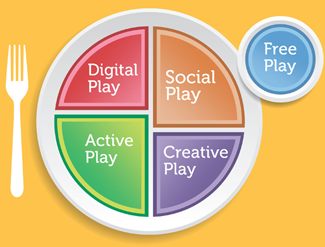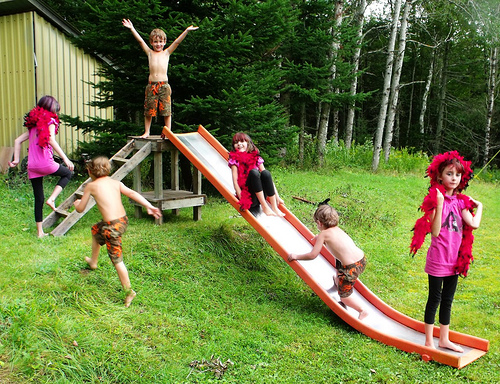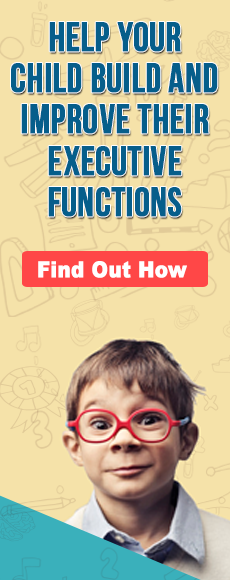What is a Play Diet?
 While video games and other digital media are essential for the academic and cognitive development of 21st Century children, here at LearningWorks for Kids we believe that such digital play is only one portion of a healthy “Play Diet.”
While video games and other digital media are essential for the academic and cognitive development of 21st Century children, here at LearningWorks for Kids we believe that such digital play is only one portion of a healthy “Play Diet.”
Just like nutritional diets, a healthy Play Diet is balanced but proportional. For children to achieve healthy development, they need spend their play time not just with Digital Play, but also with Social Play, Active Play, Creative Play, and Free Play. When it comes to nutrition, it goes without saying that one can eat too much of even the “best foods” (just think about the impact of eating too much fruit), and it works the same way when it comes to a child’s play. A child who spends all of his time on sports, while neglecting imagination games, never gets to just be free and be a kid. A child who spends hours in front of a screen, to the exclusion of active play, will not develop well-rounded social or physical skills.
The LWK PlayPlate
Inspired by the USDA’s new nutritional MyPlate, we’ve created the LearningWorks for Kids Play Plate to help parents understand how to encourage a healthy play diet for their children. Learn more about the different types of play, and how the can be balanced, by clicking on each section of the PlayPlate below.
Digital Play
Digital play is broadly defined as a voluntary, pleasurable, and energizing activity that involves the use of a range of digital technologies, including video games, websites, apps, mobile phones, iPods, tablets, writing programs, cameras, and many other technologies available for kids today.
While there is ongoing controversy (particularly in the media) about the value of such technologies to a child’s development, the preponderance of evidence shows that digital play is an undeniably important component of a child’s healthy Play Diet. Not only does digital play prepare children for their future in an evolving and highly technological society, the most curent research shows that the judicious use of digital media can exercise critical thinking skills, improve academic performance, and provide valuable experiences for social and emotional development as well.
At the same time, we strongly believe that setting limits on this type of play, particularly for younger children, is absolutely imperative. In addition to monitoring the amount time a child spends involved in digital play, it is also important to consider what she does with that time, the type of digital content she consumes, and what purpose her digital play time is serving for her.
For example, parents need to be vigilant about ensuring that their kids do not develop the following types of bad digital play habits:
- Using digital play as a means for self-isolation, or manifesting signs of depression or social withdrawal by spending an excessive amount of time online.
- Reducing the time spent on physical activity, academics, and unstructured play as a result of excessive digital play time.
- Using digital technologies as a “babysitter,” thereby reducing the amount of face-to-face time a child spends with her parents.
- Using digital play merely as a distraction or waste of time, instead of as a healthy part of a balanced play diet.
Social Play
 Social play is defined as an activity in which engagement and interaction with others is a core aspect of the play. It may involve playing with peers, siblings, parents, or teammates.
Social play is defined as an activity in which engagement and interaction with others is a core aspect of the play. It may involve playing with peers, siblings, parents, or teammates.
Social play involves activities such as playing a board game with family members, creating a group project at school, interacting with others while at the playground, or just hanging out and talking with friends and family members. Social play is readily combined with almost every other form of play so that children can engage in active play while being on a sports team with their peers, constructive play while building a fort with their friends, nature-based play when going on a hike with their girl scout troop, or unstructured play while playing “school”, “army”, or “house.”
Social play is a powerful tool for teaching communication skills, displaying empathy, and sharing. Social play helps to teach children future roles and the skills necessary for them to assert themselves to get what they would like, and then to adapt to what they get.
Traditionally, social play is considered to be a face-to-face activity in which all participants are directly engaged with each other. However, in today’s digital world, social play has come to also include activities such as Facebooking, texting, or playing online games with one’s peers. For example, a common after school social activity is for friends to meet online and join each other in a multiplay game with other groups of children all over the world.
The researchers at the Joan Ganz Cooney Foundation, the producers of Sesame Street, recently coined the term “joint media engagement” to describe this new form of social play that involves the use of digital media in conjunction with others. Joint media engagement includes both spontaneous and designed experiences where people use media together or observe others while using media. They suggest that joint media engagement assists teachers, parents, and other adults to use media in a social setting to support learning.
Active Play
 Active play is defined as play that has physical movement as its core component. It can take the form of organized sports, a walk in the woods, playing “tag” or “manhunt”, or working out with an “exergame” on a video game console. Active play is one of the earliest behaviors predictive of a healthy lifestyle. Active children are more likely to be active, physically healthy adults. Scientists have just recently collected research evidence that connects vigorous physical activity with stress management, learning, and improved attention span.
Active play is defined as play that has physical movement as its core component. It can take the form of organized sports, a walk in the woods, playing “tag” or “manhunt”, or working out with an “exergame” on a video game console. Active play is one of the earliest behaviors predictive of a healthy lifestyle. Active children are more likely to be active, physically healthy adults. Scientists have just recently collected research evidence that connects vigorous physical activity with stress management, learning, and improved attention span.
One result of active play can be seen in children who attempt to master a particular sport.
These children develop the skills of practice and persistence that are needed to succeed in other areas of their lives. Children whose physical activity takes place in organized sports, experience opportunities to learn to play by the rules, experience the joy of winning and the frustration of losing, and learn important skills for getting along with teammates and others.
Active play can readily be combined with other forms of play. Children who participate in activities that take place predominantly outdoors may develop a love of nature and the environment. Imaginative, active play in the form of playing “army” or “airsoft” with a group of friends is a great opportunity for movement and excitement. Active play can be readily combined with learning; listening to an audiobook while going for a walk or reading an engaging novel while working out on an exercise bike or elliptical machine.
Traditional views of active play have not included the use of digital media. One of the most common arguments against the use of video games is the idea that players sit on a chair staring at a screen. Today’s movement-based game systems such as the Nintendo Wii, Play Station Move, and XBox 360 Kinect, account for the increasing percentage of video game purchases and play. A number of recent studies indicate that physical activity while playing movement-based games uses more calories than brisk walking, and all age groups (including many moms) report intense physical activity and workouts with these activity-based games.
Creative Play
 Creative play for younger children often involves imagination and pretending, and for older children it often involves innovation and exploration. Creative play commonly uses materials and tools such as art supplies, musical instruments, or a programming language.
Creative play for younger children often involves imagination and pretending, and for older children it often involves innovation and exploration. Creative play commonly uses materials and tools such as art supplies, musical instruments, or a programming language.
Creative play is an opportunity for a child to explore her interests and skills. It involves developing artistic talents such as music or painting, and may involve constructive play such as building, mechanical, or engineering play activities.
Creative play has often been described as antithetical to the use of digital media and technologies. However, recent research suggests that children who play with digital media are actually more creative than those who do not use video games and other technology.
While it is important that younger children be encouraged to engage in hands-on, sensory-motor activities for creativity, there are a variety of opportunities for creative play in many of the art, graphics, and content creation applications for computers and tablets. Elementary school students, who learn to create their own games and media with tools such as Scratch and Gamestar Mechanic, have a new forum for creativity. For teenagers, who tend to move away from traditional forms of creative play, digital media and tools are a great opportunity for them to explore their creative sides by creating videos, editing multi-modal presentations for school, and making music. A variety of electronic gadgets and tools, such as video cameras, blogging software, and social-networking tools are fantastic possibilities for creativity and innovation with teenagers.
Free Play
 Free Play is play without any particular structure or rules, except those that the players decide upon in the moment. It reflects the importance of playing for the sake of playing, without the need for any goal, outcome, winners, or losers. Free play is important for learning as it encourages curiosity, abstract thinking, and problem solving skills.
Free Play is play without any particular structure or rules, except those that the players decide upon in the moment. It reflects the importance of playing for the sake of playing, without the need for any goal, outcome, winners, or losers. Free play is important for learning as it encourages curiosity, abstract thinking, and problem solving skills.
Free play is a particularly important opportunity for younger children, as it encourages them to use their imagination, try new roles, and engage in make-believe and symbolic games. At a younger age, play tends to be more sensory-motor, focusing on physical activities and sensations, rather than on communication or mastery. As kids get older, free play tends to take on a less important role in kids lives, as it is replaced by more organized pastimes like sports, music, martial arts, or dance.
While technology is rarely used in free play by younger children, older kids may find that digital media offers opportunities for the kind of imagination play and unstructured exploration that they no longer engage in with their friends and peers. Taking on the role of a fantasy character in an online role playing game or simply surfing the Internet for amusing videos and websites can be a great way for older kids to have fun outside of the confines of structured activity.





